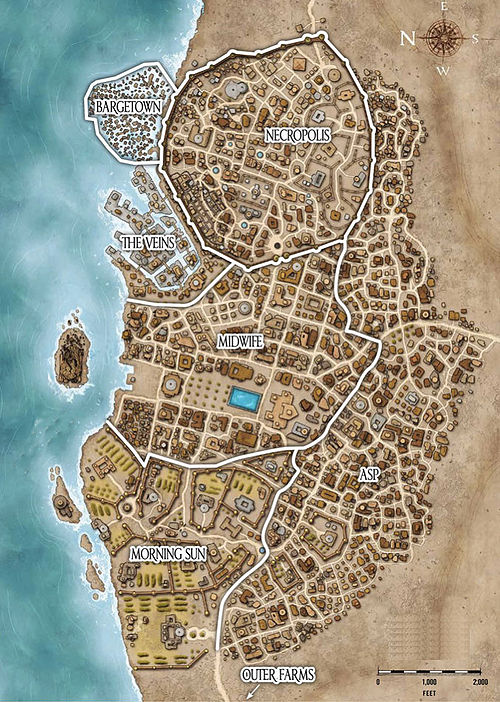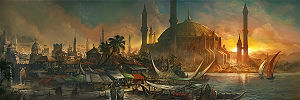Shibatti
From Krystallos
Settlement Sheet
- Lawful Neutral Small City
- Corruption +2 • Crime +1 • Economy +0 • Law +4 • Lore +5 • Society +1
- Qualities: Artist's Colony, City of the Dead, Racial Enclave, Sacred Animals.
- Danger: +5
- Government: Colonial (Sultan)
- Population: 8,300 (6,670 kobolds ; 1,292 humans; 73 dwarves; 26 gnomes; 239 other)
- Base Value: 4,000 gp; Purchase Limit: 25,000 gp; Spellcasting: 6th
- Minor Items: 4d4; Medium Items: 3d4; Major Items: 1d6
10 Facts About Shibbati, the Half-Dead City
- Shibbati is famous as a city that is 1/3rd necropolis. The original Shibbati was walled off during the Age of the Injured Turtle and accounts for roughly 1/3rd of the city's real estate. The other 2/3rds consist of newer construction. The population is mostly kobold with humans making up the second largest group.
- Shibbati is technically ruled by a sultan Oshep the Grower ibn Saaed Kahmed (long may he reign) and his advisors, the Court of Viziers but the most powerful political force in the city is the Cult of Ausar the Green-scaled.
- The Temple of Opal dominates the city's landscape and serves as a defacto city hall. The chief priestess of the temple is Sebti the Crocodile ibn Hosni Neb-at. She belongs to the Cult of Ausar the Green-scaled and has been chief priestess for a full decade. The Host of Bones, the militant branch of the Cult of Ausar the Green-scaled, uses the Temple as a headquarters. The Host of Bones exists to destroy any undead found within the necropolis.
- During the Day of Bones, a festival that honors the departed the surface of a large, artificial pool is coated in gold dust. This gives the pool its name, the Golden Pool. The Golden Pool is home to a rare breed of white crocodile that is sacred to the Cult of Ausuar the Green-scaled. The keeper of the Crocodile is brother to chief priestess Sebti the Crocodile.
- Many of the traditions of Shibbati harken back to the culture of the ancient Kingdom of Citrine. Even modern Citrinic citizens can find Shibbati to be a confusing place. Ancient Citrinic is still spoken by some residents.
- The best place to find illicit goods is Bargetown, a collection of barges, raft and boats lashed together in a makeshift district floating on the River Ankh.
- The city guard of Shibbati are known locally as the Blinders. The nickname harkens back to a day when the putting out of an eye was a common punishment for criminals.
- Perhaps the most dangerous of Shibbati's exports is Mumia, an alchemically prepared drug made from the flesh of the mummified dead.
- Many adventurers use Shibbati as a base of operations while they explore the southern Citrine Wastes. One of the most popular place for adventurers to stay is the Kobold's Tail Inn. Ironically, the owners of the Inn, Shammen and Shema, are elves.
- The Temple of Citrine in Shibbati is the smallest in any city in the Grand Sultanate. A small guild of dedicated engineers call the temple home and specialize in crafting location-based security systems that are exported all across Krystallos.
Districts
- Necropolis: The Necropolis is roughly half of the original city of Shibatti. During 201 of the Age of the Injured Turtle the city was struck by the Plague of Madness, a disease of insanity that spread quickly. To save the rest if the Kingdom, the city was walled and sealed off. Since that day the necropolis has been a memorial to the dead and attended to only by the Cult of Ausar the Green-scaled.
- Asp: This long, winding district of low buildings and twisting alleyways runs along Shibatti's southern edge. Asp was built without the planning or engineering insight of the city's core, making navigation difficult for newcomers. Few of Asp's residents think of themselves as members of a common community the way inhabitants of Midwife or Morning Sun might. Instead, the district is a loose alliance of dozens of blocks, neighborhoods, and streets all pursuing their own agendas. These associations hold bitter rivalries as ell, usually along economic lines, which run from the well-off estates in the west to the slums of mud-brick hovels huddling against the walls of the necropolis in the east.
- Bargetown: Shibatti's unwashed masses, heretics, and down-on-their-luck foreigners gather in this semipermanent floating district literally built atop the Ankh River. Lashed vessels replace buildings, and narrow planks and rope railings make up Bargetown's rickety streets. Each family maintains their own tiny barge or keelboat, and joins the community for a length of time measuring from days to years. The layout of Bargetown is constantly shifting. The downtrodden bargers supply most of Shabatti's fish and shellfish, drawn from the Ankh's sacred waters. The crocodiles and giant crayfish that prowl the river are a constant threat to the bargers, scavenging leftovers, waste, and the occasional drunk who falls into the water.
- Midwife: The district of Midwife is the heart of Shibatti, cradling most of the city's temples, markets and professional artisans. Along with the necropolis, Midwife is the oldest of Shibatti's districts, with a history stretching back to the city's founding, and it's residents take pride in maintaining their ancient community. Midwife's buildings, carved from stone and towering two to six stories tall, reflect the grandeur of the old Kingdom and house a wide variety of shops, apartments, and workshops.
- Morning Sun: The majority of Shibatti's wealthiest estates sit on a small rise of Midwife called Morning Sun, so named because the district enjoys the first touch of the Sky Turtle's rays at dawn. Morning Sun is the city's least populous district, containing a mere two dozen wealthy estates tht consist of palatial homes, storage buildings, servant's quarters, orchards, vineyards, and a handful of lavish apartments - all of which are colorful, well maintained, and surrounded with lush gardens and statuary.
- Outer Farms: West of Shibatti, beyond the stable sandstone shelf upon which the city rests, miles of silty, verdant farmland stretch along the banks of the river. Barley, beans, cabbage, cucumbers, flax, garlic, melons, and millet fill the fields, but onions reign supreme on every farm.
- The Veins: Nestled between Midwife and Bargetown, Shibatti's harbor district stacks block upon block with woodcarvers, trapmakers, tar kilns, warehouses, and whatever shanties can be crammed between them.
| Pathfinder: Krystallos | ||
| Setting • People • Locations • Monsters • Journal • House Rules • Noteboard |

